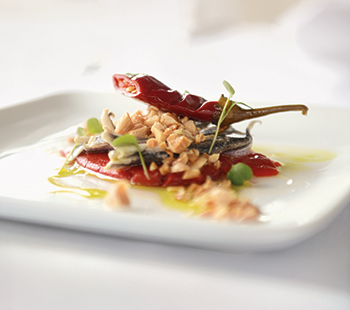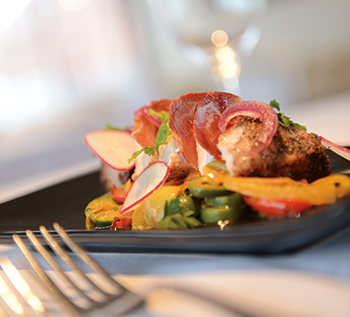
Reviewed by Wini Moranville
The thrill starts with the view. Is there any restaurant in Des Moines that more dashingly frames our cityscape? The eye sweeps the graceful curve of the Wellmark building and the copper glow of the library, while beyond, you can glimpse the Ruan Center’s glimmering lights and 801 Grand’s commanding skyline presence.
Doc Wilson’s cocktails will only lift you higher. Doc is the alter ego of chef-owner Sean Wilson, who is as artful behind the bar as he is in the kitchen. He house-infuses spirits, crafts his own vermouths and bitters, and best of all, creates cocktails that distinguish themselves through sheer sophistication. That’s because Wilson’s libations eschew those overly sweet neo-martinis preferred by newbie drinkers who haven’t yet been weaned from a childhood of too much sugar.
I spotted no wedding cake- or PB&J–flavored vodkas behind the bar.


Take, for instance, the Moroccan 75, a heady turn on the classic French 75, with tequila, Cointreau, passion fruit and orange juice swirling around subtle hints of Fresno chili—a touch that registered more as a refreshing spark than as kick-in-the-head heat. (And, let’s not forget that chilies, like alcohol, can be mood enhancers.)
Or try the questionable-sounding but delightful Harrison Tonic, with bourbon, lemon juice, and—of all things—celery syrup, which brings unimaginable smoothness to the drink.
Wilson’s cocktails do exactly what a signature pre-dinner drink should do: They set the tone for what’s to come—in Proof’s case, vivid combinations that astonish the eye and bring revelations to the palate.
When Wilson and business partner Zachary Mannheimer relaunched Proof in the spring of 2012, their focus remained primarily on the lunch fare established by the restaurant’s founder, Carly Groben.
While dinner spotlighted Wilson’s cuisine, it was offered only Friday and Saturday nights. Still, heads turned, a positive buzz charged the foodie airwaves, and soon the doors swung open Wednesday through Saturday evenings.
Last autumn, when the restaurant discontinued its lunch program, the former Proof (of casual falafels and creative flatbreads) gave way to today’s Proof, where the venue’s well-established Mediterranean focus feels particularly Wilson’s own.
“I look towards Spain, Sardinia, Sicily and Italy’s east coast during the winter months,” he says. “In summer, I bring out flavors of the southern Mediterranean—Morocco, Tunisia, Libya and Egypt.”
Hence, across two winter visits, I enjoyed an array of refined small plates inspired by the northern reaches of the Mediterranean, including Spanish-influenced fresh anchovies with piquillo peppers and Marcona almonds; roasted eel glazed with saba (a thick, sweet Italian condiment made from concentrated grape must); foie gras with French horn mushrooms; and a Spanish blue cheese served with French vermouth.
What lingered most in my mind, long after my evenings there, was the kitchen’s commitment to well-placed spices. Wilson concocts his own versions of the ancient spice blends of the Middle East, such as za’atar, baharat and ras al hanout.
“We roast, we toast, we blend,” Wilson says, adding that he buys his spices in small batches to ensure that they’re never on his shelf longer than a week.
At Proof, spice is less about fire and more about a toasty warmth here, a fruity astringency there, the occasional smoke and sweetness. Wilson’s plates show what spice can do for a dish, without being all about the spice.

Berkwood Farms pork is served with green olives and braised vegetables.
That’s how, in Wilson’s hands, something as blunt and Flintstone-esque as a marrow bone comes off as refined and exquisite—the way the spices animate the creamy, unctuous marrow makes it so.
A touch of sumac—a spice made of dried and ground purple-red berry—adds brightness to the deeply flavored, bacon-wrapped warm rabbit terrine. Piment d’Espelette—made from dried peppers grown in France’s Basque region—brings its subtle spicy-fruity kick to a velvety-rich scallop.
Even the pepper sprinkled on steaks isn’t just pepper—it’s a blend of ground pink and black peppercorns and coriander.
Or, as front-of-the-house pro (and well-known tomato horticulturalist) Jennie Smith put it: “Sean does great things with fat and spice.”
Smith oversees a team of committed servers, who, in recent visits, orchestrated the dining adventure with confidence and finesse. The only glitch in the experience: The volume can climb when the venue is filled with the energetic buzz of diners; this would not be my choice for a hushed and intimate evening.
Until recently, dinner focused either on three-course prix fixe menus or the “submit” option—in which, for a fixed price, the chef would continue to create and serve dishes until the diner was blissed out. Sadly, some diners misunderstood the submit quest: What was meant to be something like “eat until you can swoon no more” became more like “eat until you can brag about how much you ate. “
Now, diners may choose from an array of small and large plates, though if you want a chef-orchestrated arc of the meal—the rising action of a first course, the climax of the main dish and the denouement of dessert—you can still chose a prix fixe option.
Although the submit option may have gone the way of all things, as spring arrives and Wilson’s inspiration moves to the southern reaches of the Mediterranean, I’ll be submitting myself to this kitchen’s mastery, and finding plenty of reasons to swoon.
Proof
1301 Locust St.
244.0655
proofrestaurant.com







